#Augmented Reality for Construction
Text
Unity's Augmented Reality Revolutionizes Construction with VisualLive
Unity's Augmented Reality for Construction software VisualLive, allows real-time 3D visualisation, collaboration, and field-to-office communication across all stages of construction. These include design review, quality assurance/control, facilities management, and more.The software works by overlaying large BIM and CAD files onto job sites using augmented reality, allowing construction professionals to visualise designs and collaborate in real-time.
0 notes
Text
SIMA: Scaling Up AI Agents Across Virtual Worlds for Diverse Applications
New Post has been published on https://thedigitalinsider.com/sima-scaling-up-ai-agents-across-virtual-worlds-for-diverse-applications/
SIMA: Scaling Up AI Agents Across Virtual Worlds for Diverse Applications
Amidst swift advancements in Artificial Intelligence (AI), Google DeepMind’s Scalable Instructable Multiworld Agent (SIMA) represents a substantial advancement. This innovative AI agent is engineered to perform tasks within many 3D virtual environments, demonstrating exceptional adaptability and learning capabilities like human cognition.
The emergence of AI agents like SIMA is pivotal in virtual domains. As these environments become more complex and accurate to life, the necessity for intelligent agents that can facilitate authentic user interactions intensifies. The SIMA agent is not just a character in a game; it is thoroughly designed to fulfill objectives, adjust to fluctuating conditions, and exhibit behaviors that intensify virtual environments’ realism and immersive nature.
The Evolution of SIMA
Initially envisioned as a leap beyond conventional AI agents confined to single games, SIMA was designed to be a multifaceted agent capable of traversing and learning within various virtual worlds. Google DeepMind recognized the potential of dynamic video game environments as a rich ground for AI advancement and thus initiated the SIMA project.
The team began with Atari games but then aimed for a more ambitious goal of creating an AI that could handle tasks across different gaming platforms. This shift was a significant step in AI research, aiming to make an agent that could adapt to various virtual worlds.
As SIMA developed, it achieved significant milestones, showing its growing skills and the team’s expanding goals. It could follow natural-language commands in games, showing a human-like understanding. Working with game developers, SIMA trained across different games, mastering skills like object manipulation and understanding the game world.
Today, SIMA agents have over 600 abilities, including navigation and object interaction. They can quickly respond to commands, from simple ones like “turn left” to more complex ones like “climb the ladder” or “open the map,” usually within about 10 seconds.
SIMA’s progress highlights how AI can enhance virtual experiences and pave the way for real-world applications. Its ongoing refinement indicates continued innovation in AI, changing how we interact with virtual worlds and beyond.
Exploring SIMA’s Architecture
SIMA’s architecture revolves around the integration of advanced vision and language models. These models work together to interpret and interact with diverse 3D virtual environments. By fine-tuning pre-trained models to specific game settings, SIMA can understand and execute tasks based on human instructions, demonstrating human-like capabilities.
The SIMA training process involves collaborating with multiple game studios and exposing the agent to various video games and research environments. This diverse exposure allows SIMA to learn from numerous experiences, from primary navigation to complex tasks like resource mining or item crafting in games such as No Man’s Sky and Teardown. By recording human players’ actions and instructions across different games, SIMA generalizes knowledge across tasks and environments, exhibiting remarkable zero-shot capabilities.
Despite challenges like real-time execution delays and network latency, SIMA has persevered and achieved significant milestones. It has mastered the art of grounding language in perception and embodied actions, an essential step in enabling it to perform complex tasks across multiple simulated worlds. This advancement represents creating a general AI that can understand and follow arbitrary language instructions in any 3D environment.
Case Studies of SIMA’s Successful Deployments
SIMA’s application extends beyond gaming into real-world scenarios, reflecting its versatility and potential impact. SIMA’s deployment within the vast universe of “No Man’s Sky” highlights its navigational and task-performing abilities in gaming. This demonstrates potential applications in real-world exploration tasks, such as search and rescue operations or planetary exploration.
Similarly, in the Construction Lab environment, where SIMA agents build sculptures from blocks, its object manipulation skills hint at applications in construction or manufacturing.
SIMA’s AI technology holds promise across diverse industries. In healthcare, it could revolutionize simulation training for medical professionals. Educational settings could benefit from interactive learning environments simulating historical events or scientific phenomena, offering students immersive experiences.
As SIMA progresses, ethical considerations remain paramount. Its deployment must prioritize responsible interactions and adaptability without game-specific programming, ensuring it remains beneficial to humanity. While detailed case studies of SIMA’s real-world deployment are limited, its foundational work in gaming environments suggests potential impacts across industries.
The Future of SIMA and Virtual World Interactions
Looking ahead, SIMA represents a groundbreaking innovation, signaling a new era in the relationship between AI and virtual worlds.
The evolution of SIMA is ready to lead to a new wave of AI agents characterized by remarkable sophistication. The next generation of SIMA agents is expected to exhibit enhanced autonomy and adaptability, equipped with advanced cognitive abilities that enable them to perform complex tasks without human guidance. Applying advanced machine learning techniques will likely empower these agents to assimilate knowledge from their interactions, adjust to novel environments perfectly, and make real-time decisions.
The implications of SIMA for Virtual Reality (VR) and Augmented Reality (AR) technologies are profound. We can envision a future where SIMA agents enrich VR experiences by creating dynamic environments that react to user inputs. In AR, SIMA could provide context-sensitive overlays that augment our interaction with the physical world, effectively diminishing the divide between our physical and digital experiences. This combination of AI with VR and AR promises to deliver immersive experiences that were once a dream.
As the capabilities of AI agents like SIMA advance, ethical considerations must remain at the core of development. It is imperative that the progression of SIMA-like agents align with the principles of fairness, transparency, and accountability. This ethical framework is essential to avoid reinforcing biases and infringing on privacy and to ensure that these agents contribute positively to human welfare, uphold human rights, and strengthen sustainable practices.
The Bottom Line
In conclusion, SIMA is a pivotal advancement in AI technology, opening boundless opportunities to enhance virtual experiences and real-world applications. Its evolution from gaming origins to diverse sectors highlights its adaptability and profound impact. As SIMA continues to progress, collaborative efforts in research and development are vital for responsible deployment and ethical considerations.
However, ethical considerations remain paramount to ensure its responsible deployment and alignment with principles of fairness and accountability. With collaborative efforts, SIMA indicates a future where AI enriches our lives in meaningful and impactful ways.
#3d#agent#agents#ai#ai agent#AI AGENTS#AI research#applications#ar#architecture#Art#artificial#Artificial Intelligence#augmented reality#cognition#cognitive abilities#collaborative#construction#DeepMind#deployment#developers#development#domains#Environment#Events#Evolution#framework#Future#game#games
0 notes
Text

Desde Blog Arte Plus:
Construcción de muro con realidad aumentada.
[ acceder ]
#realidad aumentada#augmented reality#AR#construcción#digital construction#construction#tecnologia#innovación#princeton university#From Finding Lab#Skidmore#Skidmore Owings & Merrill ~ SOM.#architecture#arquitectura
0 notes
Text
What is the impact of 3D Modeling in Revit for the Construction Industry in 2024?
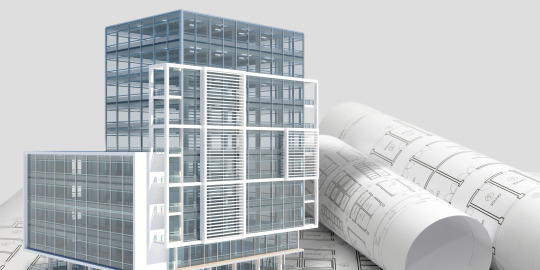
Introduction
In the realm of construction, precision, efficiency, and collaboration are paramount. The evolution of technology has significantly transformed the landscape of the construction industry, introducing innovative tools and methodologies to streamline processes and enhance project outcomes. Among these advancements, 3D modeling in Revit has emerged as a game-changer, revolutionizing how construction projects are planned, designed, and executed. As we delve into 2024, the significance of 3D modeling in Revit for the construction industry has only continued to escalate, offering multifaceted benefits that shape the future of construction practices.
The Evolution of 3D Modeling in Revit
Revit, introduced by Autodesk, has become synonymous with Building Information Modeling (BIM), a process that involves the creation and management of digital representations of the physical and functional characteristics of places. Over the years, Revit has evolved from a simple drafting tool to a comprehensive platform that enables architects, engineers, and construction professionals to collaborate seamlessly on building projects. One of the most impactful features of Revit is its robust 3D modeling capabilities, allowing users to create accurate, detailed, and intelligent models of buildings and infrastructure.
Why is Revit 3D Modeling Beneficial in Construction?
1. Enhanced Visualization:
3D modeling in Revit offers unparalleled visualization capabilities, allowing stakeholders to visualize the project realistically before construction commences. This enables architects and designers to convey their ideas more effectively, facilitating better decision-making and reducing the likelihood of errors or misinterpretations during the construction phase.
2. Improved Coordination and Collaboration:
Collaboration is at the core of successful construction projects, and 3D modeling in Revit fosters enhanced coordination among various stakeholders, including architects, engineers, contractors, and clients. By working on a shared digital platform, team members can collaborate in real time, exchange feedback, and resolve conflicts more efficiently, leading to smoother project workflows and improved project outcomes.
3. Streamlined Design and Documentation:
Revit’s 3D modeling capabilities streamline the design and documentation process, enabling designers to create detailed models that contain rich information about building components, materials, and specifications. This not only facilitates accurate quantity takeoffs and cost estimations but also expedites the preparation of construction documents, such as plans, sections, and elevations, thereby accelerating the overall project timeline.
4. Clash Detection and Risk Mitigation:
One of the key advantages of 3D modeling in Revit is its ability to detect clashes and conflicts within the building model. By conducting clash detection analyses, construction teams can identify potential clashes between different building systems, such as structural, mechanical, electrical, and plumbing, at an early stage. This proactive approach helps mitigate risks, prevent rework, and ensure smoother construction progress on-site.
5. Sustainable Design and Building Performance Analysis:
In an era where sustainability is a top priority in construction, Revit’s 3D modeling capabilities empower architects and designers to integrate sustainable design principles into their projects. With tools for energy analysis, daylighting simulation, and material selection, Revit enables stakeholders to evaluate the environmental performance of buildings and make informed decisions that minimize environmental impact and optimize energy efficiency.
6. Adaptive Reuse and Facility Management:
Beyond the construction phase, 3D modeling in Revit continues to add value throughout the lifecycle of a building. Revit facilitates adaptive reuse projects by creating accurate digital representations of existing structures, where old buildings are repurposed for new functions. Additionally, these models serve as valuable assets for facility management, enabling building owners and operators to manage maintenance, operations, and renovations over time efficiently.
The Future of 3D Modeling in Revit:
Looking ahead to the future, the role of 3D modeling in Revit is poised to become even more integral to the construction industry. Advancements in technology, such as artificial intelligence (AI), virtual reality (VR), and augmented reality (AR), are expected to further enhance the capabilities of Revit, enabling more immersive design experiences, predictive analytics, and real-time collaboration. Moreover, as sustainability and digitalization continue to shape the construction landscape, Revit will play a crucial role in driving innovation and delivering sustainable, resilient, and high-performing built environments.
Conclusion
In conclusion, the importance of 3D modeling in Revit for the construction industry in 2024 cannot be overstated. From enhanced visualization and improved coordination to streamlined design and sustainable building performance analysis, Revit’s 3D modeling capabilities offer a myriad of benefits that drive efficiency, accuracy, and collaboration throughout the project lifecycle. As technology continues to evolve and new challenges emerge, Revit remains at the forefront of innovation, empowering construction professionals to realize their vision and shape the future of the built environment. Embracing 3D modeling in Revit is not just about adopting a tool; it’s about embracing a transformative approach to construction that enables us to build smarter, better, and more sustainable.
#artificial intelligence#virtual reality#augmented reality#3D Modeling in Revit#Construction 2024#Construction Industry 2024#3D modeling#Revit
0 notes
Text
Whatever It Is
Whatever It Is
Another New Studio
I’ve had a mixed January after time off over Christmas. Lots of time spent trying to get an app from Unity onto the app store, I must have spent twenty hours and it still won’t go on so I’ve resorted to putting the Doncaster Platonics app on the Artivive App.
It works, which is great, but it costs money to use for anything other than minimal output and there…
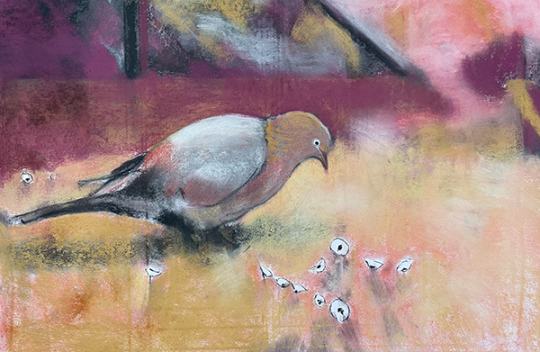
View On WordPress
#3d#AR#Art#Augmented Reality#Construction#Creative#Drawing#Garden#Gardens#New#Painting#prevarication#Sculpture#studio#stuff#Technology#Thinking#WIP
0 notes
Text
VR IN CONSTRUCTION
Technological advancements occur when technologies or applied sciences become more precise, accurate, efficient or more powerful or capable.Clive James, a Broadcaster and Journalist once quoted ”It is only when they go wrong that machines remind you how powerful they are”.
Augmented Reality and Virtual Reality are technologies that are transforming the way we interact with digital content and the physical world. AR overlays digital information to the real world, enhancing user experiences in fields like gaming, retail and education. VR provides immersive and stimulated environments, offering opportunities in fields such as entertainment, training, and architecture.
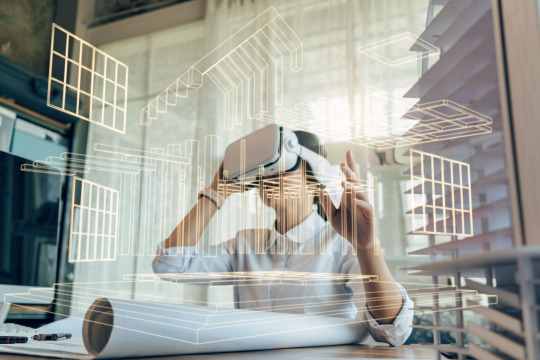
Virtual Reality(VR) technology has numerous benefits to the field of architecture, revolutionising the way architects design, present and experience buildings. It has emerged as a game changing technology in the construction industry, revolutionising how construction projects are planned.designed and executed. By creating immersive and realistic virtual environments, VR enables construction professionals to visualise and experience projects before they are built. Architects, engineers and clients can walk through virtual models of buildings, gaming a deeper understanding of the design, spatial layout and aesthetics.The immersive experience helps identify potential issues,clashes or design flaws early on, leading to better-informed decisions and reducing costly errors during the construction phase. VR also facilitates collaborative decision-making, allowing stakeholders to virtually come together and discuss project details, review designs, and coordinate activities. Workers can benefit from VR in construction based training programs, using virtual environments to practise tasks, safety protocols and equipment operation, ultimately improving job safety and efficiency. Moreover, Virtual Reality enhances client engagement and marketing efforts as clients can virtually explore and experience the final product, fostering a stronger connection to the project. With its ability to enhance visualisation, improve collaboration,mitigate risk, and streamline construction processes, virtual reality is transforming the construction industry,paving the way for more efficient and successful construction projects.
Virtual Reality is one kind of an ease in technological advancement created. While there are numerous benefits to implementing VR in construction, there are also some challenges and limitations too.Some of the boons to the virtual reality are:
Enhanced Visualisation: VR in construction allows companies to visualise architectural designs, building plans and 3d models in an immersive and realistic manner. It helps stakeholders understand the project's scope, spatial relationships and aesthetic elements before the construction process begins.
Improved Design and Planning : With VR in construction, architects and engineers can create virtual prototypes and simulate various design options, They can identify design flaws or clashes early on and make necessary adjustments, reducing errors and rework during construction. VR also facilitates better collaboration among project stakeholders during the planning phase.
Safety Training: Virtual Reality can provide a safe and controlled environment for training construction workers in hazardous situations.It allows them to practise safety procedures, such as working at heights, operating heavy machinery or dealing with emergencies, without exposing them to real world risks, This can significantly reduce accidents and improve on-site safety
Some of the bans of VR in construction are:
High Initial Costs: Implementing VR technology in construction requires significant upfront investment in hardware,software and training. The costs of VR headsets, computers with processing power, and specialised software can be prohibitive for smaller construction firms or projects with limited budgets
Technical Limitations: VR experience depends on the quality of hardware and software available. While VR technology has advanced, there may still be limitations in terms of display resolution, tracking accuracy, and the realism of virtual environments. These limitations can impact the level of immersion and realism experienced by users.
Learning Curve: Adopting VR technology in construction necessitates training and familiarisation with new tools and software. Construction professionals , especially older or less tech- savvy individuals, may require time to adapt to the new workflows and processes associated with VR. This learning curve can slow down initial implementation and affect productivity temporarily.
Limited Physical Interaction: Virtual Reality primarily focuses on visual and auditory experiences, limiting physical interaction with virtual objects. While this is suitable for many design and planning tasks, it may not fully capture the tactile and haptic feedback required for certain construction activities, such as fine detailing, material handling, or equipment operation
In conclusion, Virtual Reality technology presents significant potential in the construction industry. The boons of VR in construction include enhanced visualization, improved design and planning, safety training and remote collaboration. These benefits can lead to better project understanding, reduced errors, enhanced on-safety and streamlined communication among stakeholders. However challenges such as high initial costs, technical limitations, a learning curve and limited physical interaction must be considered. Despite these challenges, the ongoing advancements in VR technology offer the prospect of overcoming limitations and maximizing its benefits. As construction professionals and industry stakeholders become more open to embracing new technology and adapt to evolving workflows, VR has the potential to revolutionize the construction process, improve project outcomes and drive efficiency in the industry.
1 note
·
View note
Text

#To support the necessary design#procurement#manufacturing#and construction operations for the building#BIM will include comprehensive engineering and introducing new technology Although all developing technologies have advantages of their ow#many academics have employed BIM integration with other emerging technologies because of the AEC industry's higher potential. As an illustr#consider how BIM may be integrated with artificial intelligence (AI)#cloud technologies#the internet of things (IoT)#virtual and augmented reality (VR/AR)#laser scanning#3D printing#and drone technology. In the AEC sector#all of these technologies are regarded as potential new technologies. Utilizing these cutting-edge technology in the AEC sector is recognis#To know more#email- [email protected]#Call- +91 7420800880#+971-504816805#To get a Quote https://lnkd.in/d7_eFTzv#results#infrastructureprojects#scan#constructionprofessionals#3dtechnology#technology#design#digital
0 notes
Text
Ficbinding: A Complete Kingdom by Komodobits


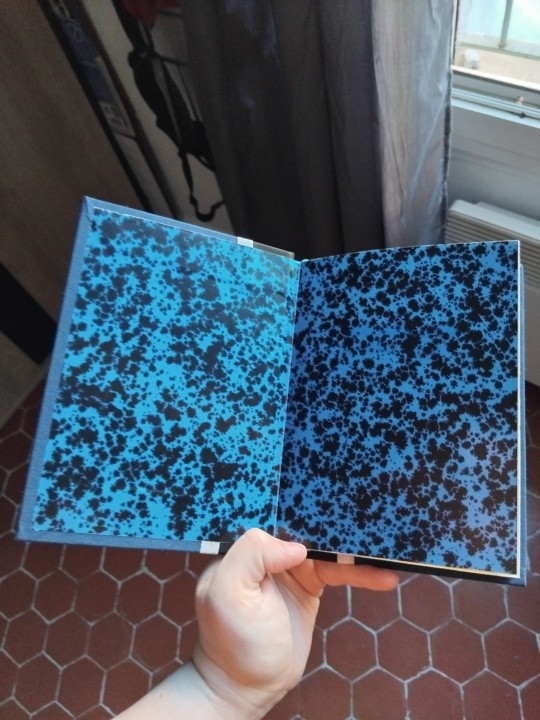

The fic: SPN, Castiel/Dean Winchester, 85k
This fic had me staying up until 2am to read, it swept me up and flattened me. It's so well-written, so faithful to the characters, so well constructed that all you can do is strap in and enjoy the ride and hope you're not sobbing by the end (a vain hope). It's such a good story, period, that I think it can be enjoyed by non-SPN people. Mind the tags. Summary:
The sea; it swallows me. It comes up to my knees and it swallows me. The boys owe Jody a few dozen favours, and so when her niece goes missing near an old fishing village on the coast of Maine, Dean, Sam, and a newly human Castiel agree to take the case on. They settle into an old abandoned lighthouse-keepers' cottage, and slowly the tide comes in. (post-s8)
The bind: I'm so proud of this one, guys. I tried new things, pretty much everything worked, and I learned new skills!
Let's start with the colors. The story is sea-themed and stormy, so I chose black, dark blue and silver for the cover and light grey and light blue for the headbands and bookmark. I meant to use white for the headbands, but discovered I don't have white ones. It's the first time I do an overlap of fabrics and it turned out awesome. The silver stripe is a simple gift wrapper ribbon.
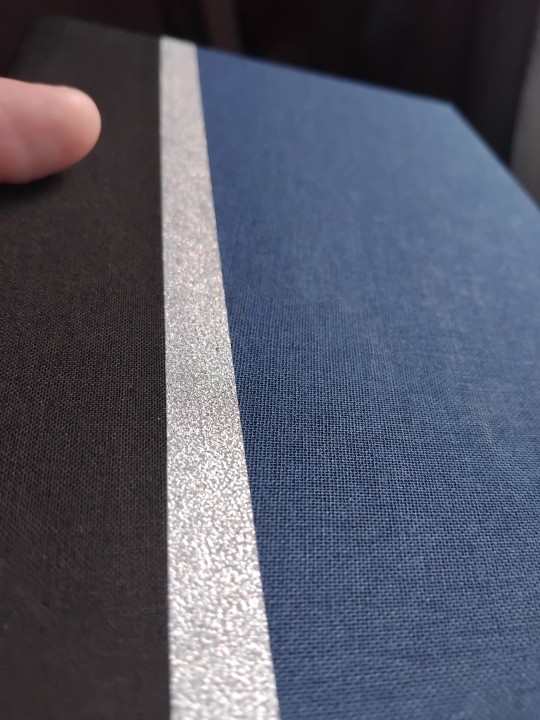

Typesetting:
The title font is so cool, with a droplet effect. For the part titles I chose a kind of blurry, hazy font because this story is about perception of reality and the loss of it. The chapter titles of the first part are solid, then they're altered in the following parts, to symbolize a slipping grasp on reality as time goes on.
I put headers and bottom-of-page numbers this time, which forced me to figure new things out in LibreOffice and do some maths 💪
The image of a lighthouse also changes in the three parts of the story. If you've read this fic, you know why.
Little wave as a divider.




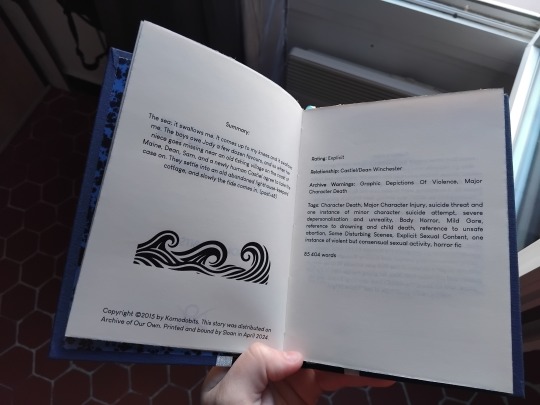

Making the book:
I hadn't made a big book (printed at the A5 format) in a while and it felt amazing going back to that. It stretched my maths muscles. It's relaxing to do a book and not have to fight for every millimeter, like with small books. It's a more forgiving format.
Trimming went amazingly this time, I'm finding my footing slowly.
I had to sandpaper the edges to color them silver. I don't mind working with sandpaper, but it's quite brutal on the book, and wouldn't do it every time.
The edge painting was made with a silver marker, so I knew it wouldn't be perfect, but it looks good enough and doesn't peel away.
My corners are improving! They look almost perfectly square.
In reaction to the last bind I made, I augmented the overhang (still don't know if that's the word) between the edge of the covers and the edge of the textblock. From 3mm to 5mm. I'm very happy with this, it looks much better!
It's rare that I'm disappointed in a fabric, so I'll highlight here that I don't like this endpaper. It's pretty, but it's a sort of glossy magazine paper that didn't react to glue so well.
Overall, I love this book and this story deeply. I think it may be my best work technically so far.
Fonts: Rained (title), Moonrising (author name), Louis George Cafe (text), Brightness, Brightness Book and Brightness inverted (chapter titles), Snorter (part titles).
Materials: 2mm grey board, 80g/m² ivory Clairfontaine A4 paper, synthetic ribbon and headbands (found on amazon), black and blue cloth and endpaper from Schmedt, silver non-textile ribbon (bought in craft store).
Feel free to ask me more about materialsand fonts (or whatever), it won’t bother me at all to tell you what I used, but I’m too lazy rn to write it in this post that’s long enough already.
24 notes
·
View notes
Text
You know, I find it funny and interesting that I ended up on the very niche part of tumblr with t4t horny transhumanism mechs. It’s especially funny because I am not anywhere near the actual target audience for that type of content. I enjoy it from an observer’s perspective, watching people go into detail about something very alien to me is entertaining, but I don’t get turned on by any of this at all.
I enjoy mechs and robots a bunch, and I find the idea of robots and mechs to be dope as shit. I am an advocate for the rights of AI and robots even if they are still only fictional, and would gladly help make mechs and robots a reality if I could. I, however, enjoy them from a purely mechanical standpoint.
When I see a robot, I don’t think “God I wish I could fuck her (rearrange her hardware inside her chassis, install harmless bloatware in her to make her overheat)” or “God I wish that I was a robot girl too”, I think “Oh man, her construction is fucking awesome, I wonder what her schematics are like, I bet she could do all kinds of shit. Imagine the modding potential too.”
When I see mechs, I don’t think about the orgasmic experience of jacking into it and becoming something better, pilot and mech fusing into one whole being and experiencing the pleasure of battle. I think of how I could construct one of those for myself, I imagine the parts necessary, I think of how I could improve on the design and further innovate.
I kinda know my place in this fictional world of transhumanist robot lesbians and mecha/pilot symbiosis. I’m essentially an asexual mechanic. I dont tinker with robots for carnal pleasure, I do it because I am simply preforming routine maintenance, please stop moaning you’re making this weird. I don’t see a mech and dream of my consciousness melding with its into a sacred union, I theorize how I could fit as much weaponry as possible onto it’s frame before it overheats from the stress.
I actually hate transhumanism. I am deeply uncomfortable with the idea of replacing parts of myself with machinery. If the world worked like that I’d probably be pretty odd. I service mechs and androids with passion but am adamantly against body modding or mech piloting. I’d be the weird girl that avoids stepping into the cockpit at all costs, the one that stares concernedly at the pilots who seem so out of it when not jacked in, the one who always seems a little squeamish around people with augments. I think it’s ok for others to do it, go crazy, I don’t mind. I just worry that the normalization will lead to it being harder to live without augmenting, like cars making cities unwalkable.
Idk, that was a lot of rambling. TL:DR I find mech and robo stuff interesting from a mechanical standpoint, and I like this kink for the plot. Yall keep wanting to fuck those bots, good for you!
78 notes
·
View notes
Text
Persevere
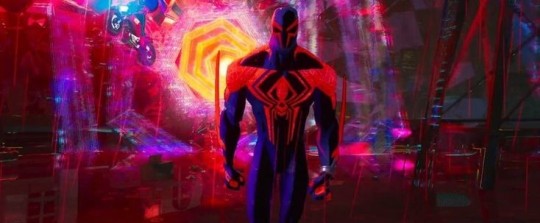
Spiderman 2099
(short action story)
Summary: Spiderman gets into a street fight with a villain
(spoiler alert: he wins)
Warnings: Violence

In the bustling metropolis of Nueva York in the year 2099, Spider-Man 2099 swung through the cityscape, a beacon of hope for its citizens. The futuristic skyscrapers gleamed with neon lights as he gracefully maneuvered between them. People below marveled at their iconic hero, inspired by his unwavering dedication to protect the city.
Spider-Man 2099 quickly leaped into action, landing gracefully in front of Mattermorph. The villain sneered, reveling in his newfound powers as he transformed nearby debris into dangerous projectiles. Spider-Man's enhanced senses detected the surge of energy emanating from the core-pin and analyzed the possibilities and limitations of Mattermorph's abilities.
Amidst the urban chaos, a disturbance rippled through the air, grabbing Spider-Man's attention. From seemingly thin air, a new villain emerged, wielding the power to manipulate matter. Known as Mattermorph, this unpredictable creature could reshape objects and elements with the energy harnessed from a core-pin on its chest.
Spider-Man leaped into action, landing before Mattermorph. The villain sneered, relishing in its newfound powers. It transformed nearby debris into dangerous projectiles, testing the limits of Spider-Man's abilities. With his heightened senses, Spider-Man analyzed Mattermorph's power source and anticipated its moves.
The battle ignited as Spider-Man evaded the onslaught, his advanced suit augmenting his agility and reflexes. His web-shooters whirred as he unleashed a flurry of webs, aiming to immobilize the formidable villain. But Mattermorph proved relentless, countering with its matter-manipulating prowess.
With each blow, Mattermorph retaliated, molding the environment to its advantage. Streets cracked open, lampposts contorted, and vehicles morphed into deadly weapons. Spider-Man utilized his web-slinging expertise, navigating through the chaos, and countering Mattermorph's attacks with precise strikes and cleverly constructed web traps. Yet, the battle intensified, pushing both combatants to their limits.
Buildings trembled as Mattermorph unleashed its full range of matter-manipulating abilities. The fabric of reality twisted and distorted with the villain's boundless power. Spider-Man knew he had to devise a new strategy to overcome this formidable foe.
In a desperate move, Mattermorph hurled a massive boulder towards Spider-Man. Swiftly swinging into action, the hero redirected the projectile using his webs. However, Mattermorph had a surprise waiting. It swiftly crafted a puppet out of brick and debris, launching it at supersonic speed towards the back of Spider-Man's head, shattering upon impact.
The double attack disoriented Spider-Man, leaving his senses entangled in a knot. Struggling to regain focus, he fought against the throbbing pain. His movements became sluggish, and his spider-sense faltered. Seizing the opportunity, Mattermorph closed in for a final strike, sensing imminent victory.
Yet, Spider-Man's indomitable spirit refused to surrender. Drawing upon his reserves of strength, he relied on instinct and muscle memory, honed through years of training and experience. Adapting his fighting style to compensate for his impaired senses and the unpredictable environment, he flowed with the battle, countering Mattermorph's every move.
Summoning a final surge of energy, Spider-Man disarmed Mattermorph, removing the core-pin from its chest. A cry of frustration and pain echoed from the defeated villain. But Spider-Man pressed on. With precision and determination, he delivered a decisive blow to the exposed core, severing the connection to Mattermorph's power source. The villain crumbled to the ground, defeated and powerless.
As the battle subsided, Spider-Man's head throbbed with pain, a testament to the toll of the fight. His suit, battered and torn, showcased the intensity of the encounter. Without wasting a moment, the hero swiftly secured Mattermorph in a cocoon of webbing, ensuring the villain's capture.
With the city now safe, Spider-Man swung away from the scene, a mix of exhaustion and satisfaction
Word count: 541
#spiderman#spiderman 2099#miguel o'hara#short story#action#nueva york#miguel o'hara x reader#spider man: across the spider verse
75 notes
·
View notes
Text
Unity's Augmented Reality Revolutionizes Construction with VisualLive
Unity's Augmented Reality for Construction software VisualLive, allows real-time 3D visualisation, collaboration, and field-to-office communication across all stages of construction. These include design review, quality assurance/control, facilities management, and more.The software works by overlaying large BIM and CAD files onto job sites using augmented reality, allowing construction professionals to visualise designs and collaborate in real-time.
0 notes
Text
List of Danny's powers:
Accelerated Healing (quickly heal and regenerate bodily tissue and organs damaged as a result of injuries)
Paranormal Immunity (resist the effects of certain or all ghost powers)
Supernatural Agility (respond to changes in the body's position with balance, bodily coordination, speed, reflexes, strength and endurance)
Supernatural Durability (incredibly resistant to damage)
Supernatural Endurance (endure vastly beyond what is naturally possible)
Supernatural Equilibrium (balance oneself more accurately and for longer duration what is naturally possible)
Supernatural Reflexes (drastically better reaction time than what is naturally possible)
Supernatural Speed (move and react at extraordinary physical speed, beyond those of normal humans)
Supernatural Stamina (indefinitely go on without sustenance, such as food or drinks)
Supernatural Strength (have and exert a level of physical strength or force much greater than what their body would allow than that of a normal person)
Flight (hover and move in the air at will)
Ghost Ray (attack by releasing ecto-energy)
Intangibility (pass through solid objects)
Invisibility (render one's body undetectable to the naked eye)
Overshadowing (possess a human, animal, or object and control its actions)
Spectral Body Manipulation (manipulate the size and shape of one's body)
Telekinesis (move objects without being in physical contact with them, by using ecto-energy)
Teleportation (move instantaneously from one location to another)
Cryokinesis (create, control and manipulate ice and snow, frost and sleet, hail and cold at will and mold into any shape and form)
Duplication (make duplicates of one's body or parts of one's body)
Pyrokinesis (generate and control fire)
Electrokinesis (generate and manipulate pure electrical/lightning-like energy into any shape or form.)
Ecto-Energy Constructions (generate constructs such as weapons and tools out of solid ecto-energy)
Energy Strike (attack by releasing ecto-energy)
Exorcism (forcefully remove ghosts from the body, object, or location they are possessing through)
Ghost Sense (sense a nearby ghost or half ghost)
Ghost Shield (barriers made of solidified ecto-energy)
Ghost Stinger (shock an enemy with ecto-energy released in the form of electricity)
Going Ghost (lets the user transform into their half ghost self)
Power Augmentation (enhance the powers of oneself)
Reality Warping (manipulate reality) (does he actually have this one or is it just the reality gauntlet that allowed him to do so?)
Ghostly Wail (generate an extremely powerful sonic blast)
Intangibility Fusion (fuse together objects, and/or people that are separate or opposite to one another)
Photokinesis (project light)
Repulsion Field (send out a pulse of energy in all directions to repel large groups of attackers)
Dark Danny's powers (that Danny didn't have in the show):
Shapeshifting (change the physical appearance of one's body to that of another living or nonliving object)
Sleep Inducement (render the user's opponent unconscious without the use of force)
Fusion (two ghosts to combine to create a new ghost)
Ghost Portal Creation (create portals between the Ghost Zone and the human world at will)
Plasticity (manipulate one's body into an elastic form)
Powers I see people use most often:
Flight, Ghost shield, Ghost sense, Overshadowing, Invisibility, Healing, Immunity, Durability, Strength, Agility, Endurance, Stamina, Intangibility, Ghost ray, Cryokinesis, Duplication, Energy strike, Going ghost(obv), Ghostly Wail
Powers I don't see people use too often:
Spectral body manipulation, Telekinesis, Teleportation, Pyrokinesis, Electrokinesis, Ecto-energy constructs, Ghost Stinger, Reality Warping, Intangibility fusion, Repulsion, Sleep inducement
(there's more for that, but I see them just a bit more than the ones on the list. it's like an in-between sorta deal. Or I don't care enough to put it on the "don't see" list.)
64 notes
·
View notes
Text
The Evolution of Architectural Experience: Unveiling the Impact of 3D Visualization and Animation

Introduction
In the realm of architecture, the transformative power of technology has been reshaping the way we perceive and interact with built environments. Among the myriad technological advancements, 3D visualization and animation stand out as catalysts for a paradigm shift in architectural experience. This article delves into the profound impact of 3D visualization and animation, exploring how these tools are revolutionizing the architectural landscape and shaping the future of design.
1. Enhanced Design Communication:
One of the foremost contributions of 3D visualization and animation to architecture is the enhancement of design communication. Traditional 2D drawings and blueprints often struggle to convey the spatial complexities and design intent effectively. 3D visualization bridges this gap by providing a more intuitive and immersive platform for architects to communicate their ideas. Stakeholders, including clients and collaborators, can now experience a virtual walkthrough of the architectural design, gaining a deeper understanding of the spatial relationships and design nuances.
2. Realism and Contextual Understanding:
3D visualization and animation enable architects to create realistic renderings that mimic the actual appearance of the proposed structure. This not only aids in visualizing the aesthetics but also facilitates a better understanding of how the building integrates into its surroundings. By incorporating contextual elements such as landscaping, lighting, and urban context, architects can present a comprehensive view of the project. This level of realism fosters informed decision-making and helps stakeholders envision the final product more tangibly.
3. Iterative Design Process:
The iterative nature of design is inherent to architecture, and 3D visualization accelerates this process. Architects can quickly generate multiple design iterations, experimenting with various forms, materials, and spatial configurations. The ability to visualize these iterations in real-time fosters a dynamic and responsive design process. This not only streamlines decision-making but also encourages creative exploration, pushing the boundaries of architectural innovation.
4. Client Engagement and Empowerment:
Empowering clients with the ability to experience a project in 3D fundamentally transforms the client-architect relationship. Clients can actively participate in the design process, providing valuable feedback based on their virtual experiences. This collaborative approach not only ensures that the final design aligns with the client's vision but also fosters a sense of ownership and engagement. 3D visualization becomes a powerful tool for democratizing the design process, making architecture more accessible and inclusive.
5. Educational Opportunities:
In architectural education, 3D visualization and animation serve as invaluable tools for both students and educators. Students can immerse themselves in lifelike simulations, gaining a practical understanding of spatial relationships, lighting dynamics, and materiality. Educators, on the other hand, can use these tools to illustrate complex architectural concepts and historical precedents, enhancing the learning experience and preparing students for the realities of modern design practice.
6. Technological Advancements and Future Prospects:
The landscape of 3D visualization and animation is continuously evolving, with emerging technologies like virtual reality (VR) and augmented reality (AR) pushing the boundaries even further. VR allows users to inhabit virtual architectural spaces, providing an unparalleled level of immersion. AR, on the other hand, overlays digital information onto the physical world, offering new ways to interact with architectural models in real time. These advancements hold the potential to redefine how we experience and engage with architecture in the years to come.
Visualization and 3D Rendering Software Market Growth
The Visualization and 3D Rendering Software Market is expected to experience significant growth by 2024, driven by factors such as the increasing demand for high-quality 3D images in various industries including gaming, architecture, and healthcare. Additionally, the growing adoption of cloud-based solutions and the advancements in virtual reality technology are also expected to contribute to the market growth. The market is projected to witness a CAGR of over 20% during the forecast period of 2019-2024.
One of the key drivers of this growth is the need for enhanced communication and collaboration in the design and construction process. 3D visualization and rendering software enable architects and designers to create realistic, immersive visualizations that accurately represent the final product. This helps stakeholders to better understand the design intent and make informed decisions throughout the project lifecycle.
Additionally, the market growth can be attributed to the increasing adoption of advanced technologies such as virtual reality (VR) and augmented reality (AR) in the visualization and rendering software industry. These technologies offer unparalleled levels of immersion and interactivity, enabling users to experience and interact with virtual environments in real-time.
Furthermore, the rise of cloud-based rendering solutions has also contributed to the growth of the visualization and 3D rendering software market. Cloud-based solutions offer a more scalable and cost-effective alternative to traditional on-premise rendering solutions, making it easier for small and medium-sized businesses to access and utilize advanced visualization and rendering technologies.
Overall, the visualization and 3D rendering software market is expected to continue its growth trajectory in the coming years, driven by advancements in technology, increasing demand for immersive and interactive visualizations, and the growing need for enhanced communication and collaboration in the design and construction process.
Conclusion
In the ever-evolving field of architecture, 3D visualization and animation have emerged as transformative tools, reshaping the way we conceive, communicate, and experience architectural design. From enhanced communication and iterative design processes to realistic renderings and client engagement, the impact of 3D visualization extends across various facets of the architectural workflow. As technology continues to advance, the future promises even more immersive and interactive experiences, positioning 3D visualization as an integral part of the architectural journey into the next era of design.
#3D visualization and animation#virtual reality (VR)#augmented reality (AR)#3D visualization and animation to architecture#3D visualization#animation#architectural#engineering#construction
1 note
·
View note
Text
Directionless Direction
Directionless Direction
Another New Studio
A trip around the studio on Friday 17th November 2023. This shows the “redfilm” [link] video in its new projection, then moves out of the booth navigating the “three red trees” sculpture and briefly views the three red garden drawings that had been framed at this date before showing the different lighting settings for the NHS lemniscate. The video…

View On WordPress
#3d#AR#Art#Augmented Reality#Construction#Creative#Drawing#Garden#Gardens#lemniscates#Poetry#Research#Sculpture#studio#Technology#Thinking#Virtual Reality#VR#WIP#WorkinProgress
0 notes
Text
Been thinking about the Crimson Cult.
(For the purposes of this post thaumic augmentation is 100% canon. Crimson Warfare is not. Also this post is long AF bc I am very autistic about this mod)
The crimson cult first appear in TC4. Cultists can be found (worshipping? studying? performing rituals?) around their obsidian altars, guarded by soldiers in their distinctive armor. When threatened, they summon reinforcements through portals.
Defeating them drops "Crimson Rites" a book that details the process for the ritual known as "Opening the Eye". However, the ritual is incomplete, and the author is clearly mad. The goal of the CC is to perfect the ritual. Interestingly, it seems this missing piece lies in Thaumaturgy.
Eventually, in the depths of madness, the Thaumaturge perfects the ritual and opens a portal to the Outer Lands, an eerie maze filled with eldritch creatures. Most interestingly, we can actually find the crimson cult here, implying that they actually succeeded. But these cultists are all dead, shambling corpses piloted by eldritch crabs. They've clearly been dead for some time, and upon inspection it's clear that their armor is old. Very old. Not only is it worn, but the design is notably different from the modern knights you encounter elsewhere.
Leaving this time period for now, we move forward by a few hundred years. The fabric of the world, the very nature of magic has shifted. The nodes, small points of primordial magic, have mysteriously dissapeared. Instead, the vis is distributed through the atmosphere in pure form. Additionally, large buildup of flux can now tear through the fabric of reality, creating rifts that eat all they come into contact with. The crimson cult is still here, but they are obviously diminished. Their altars have crumbled, and they appear to have lost sight of their original goal. They appear to have lost a significant amount of knowledge, and the new version of Crimson Rites seems to be a desperate attempt at understanding the new nature of magic and the rifts.
Whereas TC4 acknowledged the existence of other thaumaturges, and indeed other branches of magic, in TC6 the vibe is much more that you are rediscovering a forgotten art in a changed landscape. Alone.
Eventually, a new thaumaturge, with new technology, will learn how to use rift energy to blast open a more stable rift, a fracture that leads unto an entirely new, yet somehow familiar, dimension. This is the outer lands, but the structure of it has changed. The mazes have warped into large towers amidst an eldritch landscape, including vast prison complexes, libraries, and sewers, guarded by eldritch constructs. The nature of this place has changed, it is not only a testing ground but some form of prison. More shambling husks can be found here. Eventually a note can be found from an original thaumaturge, who had arrived in this land using the old method. I have more thoughts about this so they're going in their own post.
In all, these are my thoughts on the nature of the crimson cult:
The cult has existed in at least three forms over the course of time. The first version was much more powerful, and was capable of completing the apertis oculus ritual. It is this group that wrote the original Crimson Rites, before it's slow decay into mad ramblings, as well as building the altars scattered across the world. It is also this group that managed to enter the outer lands, and whose corpses we can still find wandering its halls. I believe that this version of the cult staged a major incursion into the outer lands, seeking to overcome the tests placed by the Eldritch through sheer numbers. This campaign clearly ended in disaster, resulting in the death of the majority of the cults leadership.
The second iteration is that we see in TC4, travelling through dangerous and undtable portals, desperately attempting to reclaim their lost glory and understand the secrets of the past. (I don't believe the cult comes from the outer lands, rather I think they have some headquarters in the Overworld from which they are travelling). After the thaumaturge finds the secret of the Apertis Oculus, they follow in their footsteps, finally launching another campaign into the outer lands, lead by a praetor.
I'm not sure what happens next. Either the cult regains power, and as the outer lands changes they construct the towers as fortresses that are eventually overcome, or they have nothing to do with the towers and just continue in a cycle of campaigns as the outer lands shifts, feeding more bodies to the newly constructed prisons.
Whatever happens, it's clear that the cult undergoes yet another collapse, (if indeed they did build the towers, they are overcome). By the time of TC6, they are a small group. However, they have evidently discovered the secret of stable portals, but no longer seem to be able to control their destination, appearing randomly throughout the landscape. Or perhaps they havent figured anything out at all, and the angry zombies found scattered around the world are the result of failed portals. The changing nature of the Eldritch has cut them off from the outer lands, but they seem to have some understanding of the rifts.
The cult clearly worship the eldritch, but are consistently frustrated as they fail to pass the tests set for them. Perhaps only one who can wield all the powers of thaumaturgy, drenched in the deepest madness, will be able to pass the Eldritch's tests become their champion, for whatever it is they're planning.
48 notes
·
View notes
Text

HC; Usage of the Stellaron.
I've had this sitting since I've come to witness Caelus gain access to the usage of Imaginary Path power. Through a union of this and being able to utilize the aspect of Harmony, this begins the true deal of acclimating to this power.
As it stands the Stellaron has normally remained a stationary power. With no appropriate links and a genuine fear of actually manifesting it, he's made no true moves to utilize it outside of gathering faint vestiges of that very might. From his perspective there was no genuine means to channel it, and if he were to depend on The Destruction, the stark awareness that he'd be a horrific liability compared to any assistance strikes true.
Things reached a new chapter for him however! His primary usage of the power would be based off his experiences with Cocolia in terms of beams, blasts and offensive constructs. (This being learned from her echoes and her once living form all the same) He comes to lean it on the aspect of his desires to bring momentary elements to life. (In terms of interaction.) For example, being able to weave his hat into a secondary, and frankly oversized baseball bat as if it's a sledgehammer.
Through the essence of Imaginary, he actually gets to flirt with that border of reality, bringing his own 'sense' into situations as a force of influence. For example, if facing opposition he can triumph over in influence, attacks such as lightning strikes would be shot back to such foes akin to a rubber band. Augmenting his physical form, to being able to shred heavier through natural durability (Breaking) all comes as adept advantages.
What he discovers to be the trick is two things. The depth of understanding through an imaginative lens, then the scale of Information (similar to how Corrosion makes copies). It's why he'll never be able to touch creations that hold profound significance unless a solid measure of time is spent with in, and in kind, understanding the weight of the hands that once carried it. The path of Harmony offers headway to the specialized understanding.
There's also plenty more to actively learn. Seeing how all Stellaron based opponents have actively used the essence of Imaginary to 'try' getting their jobs done, it's high time he's come to step on this plateau.
#| HCs#surprised me a lil to see how that actually had a match in 'all' those respective bosses#So y'know!#Gonna give the guy here a fair upgrade
8 notes
·
View notes
